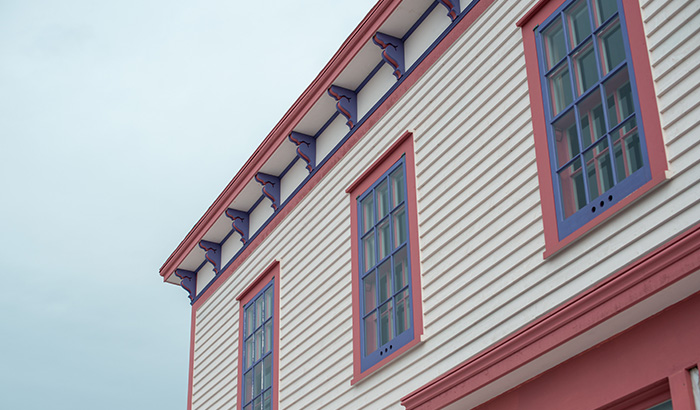
As the name suggests, single-pane windows consist of just one layer of glass within a window frame. They have been a staple in home construction for centuries, especially in older houses and historic buildings. Single-pane windows are constructed relatively simply, comprising a single sheet of glass held in place by a wooden or metal frame.
Single-pane windows have significant historical importance and can be found in many historic and traditional buildings. They were widely used before the introduction of modern double and triple-pane technologies, representing the design aesthetics of their respective eras.
Today, single-pane windows are occasionally chosen for specific applications, such as outbuildings, garages, and non-insulated structures, where energy efficiency and sound insulation are not primary concerns. Some homeowners also appreciate their classic charm and authenticity, especially when renovating or restoring historic properties.
While single-pane windows offer historical appeal and easy maintenance, there may be more energy-efficient options. In this blog, we will explore ways to improve the performance of single-pane windows and alternative solutions for upgrading to more energy-efficient options.
Understanding Energy Efficiency in Single-Pane Windows
Single-pane windows lack the insulation provided by multi-pane windows, allowing heat to easily pass through during both winter (heat loss) and summer (heat gain). This can lead to increased energy bills in colder climates and reduced effectiveness of air conditioning in warmer climates.
Two important metrics for energy efficiency are the R-Value and U-Factor. Single-pane windows have lower R-Values and higher U-Factor values than multi-pane windows, indicating their limited insulation capabilities.
Modern double or triple-pane windows with low-emissivity coatings and insulating gas offer significantly higher R-Values and lower U-Factor values, resulting in improved energy efficiency, reduced energy consumption, and enhanced comfort.
If replacing single-pane windows is not feasible, applying weatherstripping, caulking, window treatments, and exterior shading devices can help improve energy efficiency. However, upgrading to energy-efficient windows is recommended for more significant improvements.
Enhancing Sound Insulation With Single-Pane Windows
Single-pane windows typically have low Sound Transmission Class (STC) ratings, ranging from 20 to 25, offering minimal soundproofing against external noise. Modern multi-pane windows with thicker glass and insulating gas generally have higher STC ratings, providing better noise reduction capabilities.
To improve sound insulation with single-pane windows, consider the following techniques:
- Thick Curtains or Drapes: Installing heavy, dense curtains or drapes can add an extra layer of sound-absorbing material, reducing incoming noise.
- Weatherstripping and Caulking: Sealing gaps and cracks with weatherstripping and caulking can help minimize noise penetration.
- Soundproof Window Films: Applying soundproofing window films adds a sound-absorbing layer and improves sound insulation.
- White Noise Machines or Fans: Using white noise machines or fans indoors can help mask external noise, making it less noticeable.
For more significant noise reduction, explore these soundproofing options designed specifically for single-pane windows:
- Acoustic Panels: Installing acoustic panels on the interior of the window frame can significantly dampen noise by absorbing sound waves.
- Soundproof Window Inserts: Custom-made soundproof window inserts fit over the existing window, enhancing sound insulation with sound-absorbing materials.
- Secondary Glazing: Adding a second pane of glass to the interior of the single-pane window creates an additional sound barrier, especially when combined with acoustic or laminated glass.
- Exterior Sound Barriers: Planting dense shrubs or trees near the window acts as a natural sound barrier, reducing noise levels.
While these soundproofing options can improve single-pane windows’ noise reduction, it’s essential to acknowledge that multi-pane windows specifically designed for sound insulation offer more significant improvements in noise reduction.
Maintenance and Care for Single-pane Windows
Proper maintenance is crucial for preserving the condition and longevity of single-pane windows. Follow this simple cleaning and maintenance routine:
- Regular Cleaning: Clean the glass surface regularly using a mild glass cleaner or vinegar and water solution. Avoid abrasive materials or harsh chemicals.
- Check Weatherstripping: Inspect and replace worn or damaged weatherstripping to ensure a tight seal against drafts.
- Lubricate Moving Parts: Keep movable parts like sliding sashes or hinges operating smoothly by lubricating them with a silicone-based lubricant.
- Clean Window Tracks: Regularly clean the tracks for sliding windows to remove dirt and debris that could affect their functionality.
- Inspect for Damage: Periodically check the window frame and glass for cracks, chips, or signs of decay, and address any issues promptly.
Common issues with single-pane windows include condensation, drafts, leaks, fogging between panes, and sticking operation. Troubleshoot these problems with proper ventilation, weatherstripping, caulking, and lubrication.
- Minor Damage: Repairs may be cost-effective and efficient for small cracks or damaged weatherstripping.
- Fogged Glass: Fogging between the glass panes is challenging to repair in single-pane windows, making replacement a better option for improved energy efficiency and clarity.
- Extensive Damage: Extensive decay or multiple issues may warrant replacement for long-term cost-effectiveness.
- Energy Efficiency Upgrade: Consider upgrading to double or triple-pane windows for significant improvements in energy efficiency and sound insulation.
Upgrading to Energy-Efficient Alternatives
Double-pane windows consist of an additional layer of glass with insulating gas in between, offering improved energy efficiency and sound insulation. Benefits include reduced heat transfer, enhanced soundproofing, condensation reduction, and UV protection. Consider the frame material, window style, and professional installation when upgrading.
Triple-pane windows increase energy efficiency with three layers of glass and two layers of insulating gas. They offer superior thermal and sound insulation, making them ideal for cold climates, noisy environments, and energy-conscious homeowners. While they have a higher upfront cost, the long-term energy savings and comfort benefits justify the investment.
Preserving the Charm of Single-pane Windows
Restore single-pane windows with the help of professionals using period-appropriate materials and techniques. Respect the architectural integrity of the building to enhance its historical value.
Balance preservation and energy efficiency with retrofitting options like weatherstripping, secondary glazing, and Low-E window films. These solutions improve insulation without altering the original appearance.
Explore hybrid windows that combine single-pane aesthetics with modern insulation, or opt for custom designs that mimic the original look. Enhance energy efficiency with quality window treatments.
Budget-Friendly Solutions for Single-pane Windows
- Weatherstripping and Caulking
Use weatherstripping to seal gaps and cracks around the window frame, preventing drafts and heat loss. Apply caulk to block air infiltration further and enhance energy efficiency.
- Window Treatments and Coverings
Invest in heavy curtains, cellular shades, or insulating blinds to improve insulation and reduce heat transfer.
- DIY Repairs and Upgrades
Try window insulation film, rope caulk, or DIY draft snakes for affordable and effective weatherproofing solutions.
Tips for Choosing the Right Single-pane Window Replacement
Consider factors such as energy efficiency, sound insulation, budget, aesthetics, and maintenance requirements before choosing replacement windows.
Choose from frame materials like vinyl, wood, aluminum, fiberglass, or composite, each offering different benefits in terms of aesthetics and performance.
Opt for double or triple-pane windows with low-E coatings and gas fills for improved energy efficiency. Consider tinted or reflective glass for better sunlight and heat control.
Safe and Stunning Glass Services With Valley Glass
If you decide to upgrade your single-pane windows or are looking for other glass solutions, Valley Glass is your trusted partner. With our wide selection of high-quality replacement windows, expert craftsmanship, and commitment to customer satisfaction, Valley Glass offers the perfect solutions to preserve the charm of your home while enhancing energy efficiency and comfort.
Explore our range of options today or contact Valley Glass today to see how we can transform your living spaces with stunning glass and quality installation.


Leave a Reply